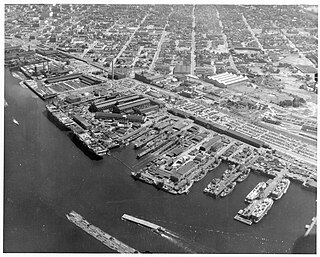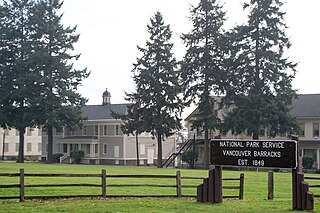
Vigor Shipyards is the current entity operating the former Todd Shipyards after its acquisition in 2011. Todd Shipyards was founded in 1916, which owned and operated shipyards on the West Coast of the United States, East Coast of the United States and the Gulf. Todd Shipyards were a major part of the Emergency Shipbuilding Program for World War II.

The Portland metropolitan area is a metro area with its core in the U.S. states of Oregon and Washington. It has 5 principal cities the largest being Portland, Oregon. The U.S. Office of Management and Budget (OMB) identifies it as the Portland–Vancouver–Hillsboro, OR–WA Metropolitan Statistical Area, a metropolitan statistical area used by the United States Census Bureau (USCB) and other entities. The OMB defines the area as comprising Clackamas, Columbia, Multnomah, Washington, and Yamhill Counties in Oregon, and Clark and Skamania Counties in Washington. The area had a population of 2,512,859 at the 2020 census, an increase of over 12% since 2010.

The Kaiser Shipyards were seven major shipbuilding yards located on the United States west coast during World War II. Kaiser ranked 20th among U.S. corporations in the value of wartime production contracts. The shipyards were owned by the Kaiser Shipbuilding Company, a creation of American industrialist Henry J. Kaiser (1882–1967), who established the shipbuilding company around 1939 in order to help meet the construction goals set by the United States Maritime Commission for merchant shipping.

Oregon Shipbuilding Corporation was a World War II emergency shipyard located along the Willamette River in Portland, Oregon, United States. The shipyard built nearly 600 Liberty and Victory ships between 1941 and 1945 under the Emergency Shipbuilding program. It was closed after the war ended.

The Swan Island Municipal Airport was a joint civil-military airport that was operational on Swan Island in Portland, Oregon. Though it officially opened in 1927, the United States Postal Service had been using the airfield for a year. After the Portland–Columbia Super Airport was completed in the late 1930s, Swan Island Municipal Airport had little use since its runways were too small for newer aircraft and the low altitude made takeoffs and landings difficult. The airport was operational for nearly two decades, but due in part to the advances in aviation, it became obsolete soon after its construction. During World War II, a Kaiser shipyard was located at Swan Island. The shipbuilding facilities were acquired by the Port of Portland after the war.

The Emergency Shipbuilding Program was a United States government effort to quickly build simple cargo ships to carry troops and materiel to allies and foreign theatres during World War II. Run by the U.S. Maritime Commission, the program built almost 6,000 ships.

The Seattle-Tacoma Shipbuilding Corporation was an American corporation which built escort carriers, destroyers, cargo ships and auxiliaries for the United States Navy and merchant marine during World War II in two yards in Puget Sound, Washington. It was the largest producer of destroyers (45) on the West Coast and the largest producer of escort carriers of various classes (56) of any United States yard active during World War II.

Commercial Iron Works was a manufacturing firm in Portland, Oregon, United States. Established in 1916, the company is best remembered today for its contribution to America's Emergency Shipbuilding Program during World War II.

Willamette Iron Works was a general foundry and machine business established in 1865 in Portland, Oregon, originally specializing in the manufacture of steamboat boilers and engines. In 1904, the company changed its name to Willamette Iron and Steel Works, under which name it operated continually until its close in 1990.

Vancouver is a city on the north bank of the Columbia River in the U.S. state of Washington, located in Clark County. Founded in 1825 and incorporated in 1857, Vancouver had a population of 190,915 as of the 2020 census, making it the fourth-most populous city in Washington state. Vancouver is the seat of government of Clark County and forms part of the Portland-Vancouver metropolitan area, the 25th-largest metropolitan area in the United States. Originally established in 1825 around Fort Vancouver, a fur-trading outpost, the city is located on the Washington–Oregon border along the Columbia River, directly north of Portland.

Northwest Steel was a structural steel fabricator and shipbuilding company in Portland, Oregon. During World War I the yard built cargo ships for the United States Shipping Board (USSB). Some 37 of the 46 ships ship built at Northwest Steel were the West boats, a series of 5,500-gross register ton (GRT) steel-hulled cargo ships built for the USSB on the West Coast of the United States as part of the World War I war effort.

The Columbia River Shipbuilding Company was a small shipyard in Portland, Oregon, United States, located on the west bank of the Willamette River. The shipyard was located at the foot of SW Sheridan Street, just upstream of the Interstate 5 Marquam Bridge, directly adjacent to the Northwest Steel shipyard.

The Kaiser Company , commonly known as the Swan Island Shipyard, was a shipyard on Swan Island in Portland, Oregon, United States. It was constructed by the Kaiser Shipbuilding Company in 1942 as part of the U.S. Maritime Commission's Emergency Shipbuilding Program in World War II. The Swan Island yard was one of three Kaiser shipyards in the Portland area, along with the Oregon Shipbuilding Corporation and the Vancouver Shipyard.
The G. M. Standifer Construction Company was an American company that built three shipyards on the Columbia River for the World War I effort, one in Oregon and two in Washington, all within spitting distance of each other. After the war it maintained its original yard in North Portland, Oregon. The North Portland yard, and one of the Vancouver, Washington yards produced wooden ships. The other Vancouver yard, located just west of what was then the Spokane, Portland and Seattle Railway bridge produced steel-hulled ships. The Portland yard was located about a mile to the west, just downstream from the BNSF bridge. Both Vancouver yards were closed in 1921.
Vigor Industrial (Vigor) is an American shipbuilding, shiprepair, and industrial service provider in the Pacific Northwest and Alaska. Based in Portland, Oregon, the company consists of several subsidiary companies for a combined total of seven facilities with ten drydocks, more than 17,000 feet of pier space, and over 2,000 employees.

Public Utility District No. 1 of Clark County, doing business as Clark Public Utilities and commonly referred to as Clark PUD, is a public utility district in Clark County, Washington. Clark PUD provides electric service to all of Clark County except for the Georgia-Pacific Camas Paper Mill in the City of Camas, and its water service area covers the majority of the county, except the Cities of Battle Ground, Camas, Ridgefield, Washougal, and Vancouver, which have their own municipal water systems.

Swan Island is located on the Willamette River about 4.5 miles (7.2 km) downriver from downtown Portland, Oregon, United States. Although presently connected to the Willamette's east bank by land fill, it existed as a river island under natural conditions.
















